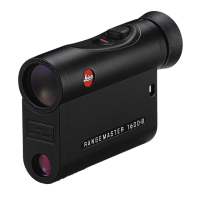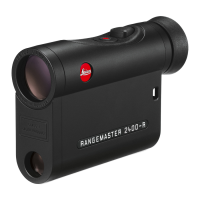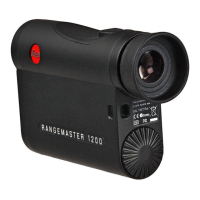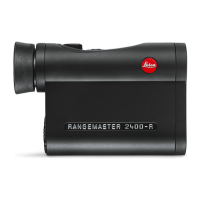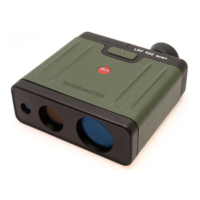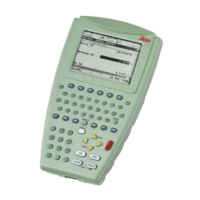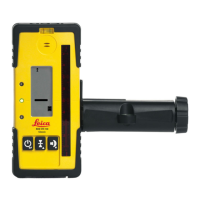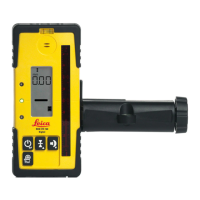Do you have a question about the Leica Rangemaster CRF 1600 and is the answer not in the manual?
Identifies the secondary button on the device for various functions.
Identifies the main button used for primary device operations.
Describes the eyecup and its dioptric scale for focus adjustment.
Identifies the eyelet for attaching a carrying cord.
Identifies the eyepiece through which the user views.
Identifies the cover for the battery compartment.
Identifies the compartment for the battery.
Identifies the device's lens.
Identifies the laser transmission optics.
Lists all items included in the product package.
Provides the product order number for reference.
Warns about potential eye injury from bright light sources.
Introduces Leica's reputation for quality and reliability in precision engineering.
Highlights key features like magnification and operational ease.
Recommends reading the instructions for optimal use and performance.
Provides instructions for responsible disposal of electronic devices and batteries.
Explains the method for securing the carrying cord to the device.
Specifies the required battery type and details installation steps.
Notes cold impact on battery, long-term storage, and proper storage.
Warns against improper handling and emphasizes proper recycling of batteries.
Describes how to identify a weak battery and its operational impact.
Explains correct eyecup position for users with and without glasses.
Details how to adjust focus using the eyecup and diopter scale.
States the available diopter correction range for vision defects.
Explains setting between metric and Imperial units.
Step-by-step guide for changing measurement units.
How the device confirms the saved setting.
Instructions on how to aim and measure distances accurately.
Describes target mark behavior during measurement.
Explains the display for distances outside the measuring range.
How to activate and use scan mode for continuous measurements.
Important notes regarding scan mode, like ballistic correction and power.
States the device's measuring accuracy and maximum range.
Lists factors influencing measuring range and accuracy.
Details ranges and accuracies under specific environmental conditions.
How to display angle of inclination, temperature, and pressure.
Explains the purpose of the holdover display for shooting accuracy.
Notes holdover is based on range, conditions, and ballistic curve.
Specifies the format (cm/100m or inches/100yds) of holdover values.
Provides an example of using holdover corrections with a riflescope.
Notes limitations for holdover corrections above 500m.
Emphasizes user responsibility for final shot assessment and accuracy.
Step-by-step guide to select the zeroing range.
Lists available zeroing range options (e.g., 100m, 200m, GEE).
How to save the selected zeroing range.
Explains choosing ballistic curves based on caliber and ammunition data.
How to use appendix tables to find the correct ballistic curve.
Illustrates selecting a ballistic curve using example data.
Step-by-step guide to set the ballistic curve.
Lists the available ballistic curve options (EU/US 1-12, OFF).
How the device confirms the saved ballistic curve.
Describes the display of range and holdover after setting a curve.
Provides examples of holdover display formats (cm/inches).
How to quickly check the set ballistic curve and zeroing range.
Describes how the ballistic curve and zeroing range are displayed.
Recommends cleaning methods for lenses and housing.
Notes on avoiding pressure, static, and chemical cleaners.
Advises noting the serial number for security purposes.
Warns against opening the device to maintain its integrity.
Directs users to Customer Service or local agents for spare parts.
Lists causes and remedies for a non-circular viewing image.
Lists causes and remedies for an unfocused display.
Explains display issues related to measurement range or reflectivity.
Lists causes and remedies for display flashing or no measurement.
Lists optical specifications like magnification and lens diameter.
Details exit pupil, twilight number, and luminous intensity.
Lists field of view, exit pupil distance, and prism type.
Describes lens coatings and diopter compensation range.
Details operating and storage temperatures, and water tightness.
Lists housing material, dimensions, and weight.
Provides battery type, life, laser classification, and beam divergence.
Describes Leica Academy seminars and information sources.
Explains how to get technical application answers via various channels.
Provides Leica's website addresses for product and company information.
Provides contact details for customer service and repair.
Explains FCC Part 15 compliance for Class B digital devices.
Lists measures to correct radio interference if it occurs.
Advises on maintaining compliance through cable use and modifications.
States the two conditions for device operation under FCC rules.
Notes compliance with Canadian ICES-003 standards.
Notes tables 1-3 show meters/cm, tables 4-5 show yards/inches.
Lists conditions for all values (pressure, temperature, shots).
Provides comments on the data presented in the tables.
Notes on table data references in multiple languages.
Lists conditions for all values (pressure, temperature, shots).
Data for holdover correction at 100m zeroing range.
Data for holdover correction at 200m zeroing range.
Data for holdover correction at GEE zeroing range.
Data for holdover correction at 100yds zeroing range.
Data for holdover correction at 200yds zeroing range.
Lists Leica trademarks and registered symbols across languages.
States that design is subject to change without notice.
Provides the company's address, website, and contact numbers.
Identifies the secondary button on the device for various functions.
Identifies the main button used for primary device operations.
Describes the eyecup and its dioptric scale for focus adjustment.
Identifies the eyelet for attaching a carrying cord.
Identifies the eyepiece through which the user views.
Identifies the cover for the battery compartment.
Identifies the compartment for the battery.
Identifies the device's lens.
Identifies the laser transmission optics.
Lists all items included in the product package.
Provides the product order number for reference.
Warns about potential eye injury from bright light sources.
Introduces Leica's reputation for quality and reliability in precision engineering.
Highlights key features like magnification and operational ease.
Recommends reading the instructions for optimal use and performance.
Provides instructions for responsible disposal of electronic devices and batteries.
Explains the method for securing the carrying cord to the device.
Specifies the required battery type and details installation steps.
Notes cold impact on battery, long-term storage, and proper storage.
Warns against improper handling and emphasizes proper recycling of batteries.
Describes how to identify a weak battery and its operational impact.
Explains correct eyecup position for users with and without glasses.
Details how to adjust focus using the eyecup and diopter scale.
States the available diopter correction range for vision defects.
Explains setting between metric and Imperial units.
Step-by-step guide for changing measurement units.
How the device confirms the saved setting.
Instructions on how to aim and measure distances accurately.
Describes target mark behavior during measurement.
Explains the display for distances outside the measuring range.
How to activate and use scan mode for continuous measurements.
Important notes regarding scan mode, like ballistic correction and power.
States the device's measuring accuracy and maximum range.
Lists factors influencing measuring range and accuracy.
Details ranges and accuracies under specific environmental conditions.
How to display angle of inclination, temperature, and pressure.
Explains the purpose of the holdover display for shooting accuracy.
Notes holdover is based on range, conditions, and ballistic curve.
Specifies the format (cm/100m or inches/100yds) of holdover values.
Provides an example of using holdover corrections with a riflescope.
Notes limitations for holdover corrections above 500m.
Emphasizes user responsibility for final shot assessment and accuracy.
Step-by-step guide to select the zeroing range.
Lists available zeroing range options (e.g., 100m, 200m, GEE).
How to save the selected zeroing range.
Explains choosing ballistic curves based on caliber and ammunition data.
How to use appendix tables to find the correct ballistic curve.
Illustrates selecting a ballistic curve using example data.
Step-by-step guide to set the ballistic curve.
Lists the available ballistic curve options (EU/US 1-12, OFF).
How the device confirms the saved ballistic curve.
Describes the display of range and holdover after setting a curve.
Provides examples of holdover display formats (cm/inches).
How to quickly check the set ballistic curve and zeroing range.
Describes how the ballistic curve and zeroing range are displayed.
Recommends cleaning methods for lenses and housing.
Notes on avoiding pressure, static, and chemical cleaners.
Advises noting the serial number for security purposes.
Warns against opening the device to maintain its integrity.
Directs users to Customer Service or local agents for spare parts.
Lists causes and remedies for a non-circular viewing image.
Lists causes and remedies for an unfocused display.
Explains display issues related to measurement range or reflectivity.
Lists causes and remedies for display flashing or no measurement.
Lists optical specifications like magnification and lens diameter.
Details exit pupil, twilight number, and luminous intensity.
Lists field of view, exit pupil distance, and prism type.
Describes lens coatings and diopter compensation range.
Details operating and storage temperatures, and water tightness.
Lists housing material, dimensions, and weight.
Provides battery type, life, laser classification, and beam divergence.
Describes Leica Academy seminars and information sources.
Explains how to get technical application answers via various channels.
Provides Leica's website addresses for product and company information.
Provides contact details for customer service and repair.
Explains FCC Part 15 compliance for Class B digital devices.
Lists measures to correct radio interference if it occurs.
Advises on maintaining compliance through cable use and modifications.
States the two conditions for device operation under FCC rules.
Notes compliance with Canadian ICES-003 standards.
Notes tables 1-3 show meters/cm, tables 4-5 show yards/inches.
Lists conditions for all values (pressure, temperature, shots).
Provides comments on the data presented in the tables.
Notes on table data references in multiple languages.
Lists conditions for all values (pressure, temperature, shots).
Data for holdover correction at 100m zeroing range.
Data for holdover correction at 200m zeroing range.
Data for holdover correction at GEE zeroing range.
Data for holdover correction at 100yds zeroing range.
Data for holdover correction at 200yds zeroing range.
Lists Leica trademarks and registered symbols across languages.
States that design is subject to change without notice.
Provides the company's address, website, and contact numbers.
| Magnification | 7x |
|---|---|
| Objective Lens Diameter | 24 mm |
| Eye Relief | 15mm |
| Exit Pupil | 3.4 mm |
| Display | LCD |
| Waterproof | Yes |
| Battery Type | CR2 |
| Measuring Range | 10 to 1600 yards |
